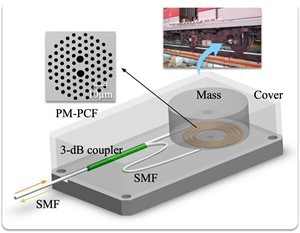Jul 18 2019
New sensors have been developed by researchers for determining vibration and acceleration on trains. The innovative technology can be incorporated with artificial intelligence to prevent catastrophic train derailments and railway accidents.
 The new fiber-optic accelerometer features a polarization-maintaining photonic crystal fiber that is coiled into the shape of a disc only 15 millimeters in diameter. When a vibration occurs, the mass block presses on the coiled fiber at a frequency matching that of the vibration. This external force causes the wavelength of light in the fiber to shift in a measurable way. (Image credit: The Hong Kong Polytechnic University)
The new fiber-optic accelerometer features a polarization-maintaining photonic crystal fiber that is coiled into the shape of a disc only 15 millimeters in diameter. When a vibration occurs, the mass block presses on the coiled fiber at a frequency matching that of the vibration. This external force causes the wavelength of light in the fiber to shift in a measurable way. (Image credit: The Hong Kong Polytechnic University)
Each year, train accidents lead to severe injuries and even deaths. Our fiber accelerometers could be used for real-time monitoring of defects in the railway track or the train to pinpoint problems before an accident occurs.
Hwa-yaw Tam, Study Team Lead, The Hong Kong Polytechnic University
The scientists have described their novel accelerometers in Optics Express—The Optical Society (OSA) journal. The instruments can detect frequencies that are more than twice that of conventional fiber-optic accelerometers, and as a result, they are suitable for observing the interactions between the wheel and rail. The sensors are durable and do not contain any moving parts. They work suitably in the high-voltage and noisy environments found in railway applications.
In addition to railway monitoring, these new accelerometers can be utilized in other vibration monitoring applications, for example, structural health monitoring for buildings and bridges and vibration measurements of aircraft wings.
Zhengyong Liu, Doctor of Philosophy, Department of Electrical Engineering, The Hong Kong Polytechnic University
All-Optical Railway Sensing
The scientists have been working on condition-monitoring systems for more than 15 years. These systems utilize an all-optical sensing network to constantly to track major railway components. In addition, they can help in substituting costly and inefficient planned railway maintenance routines with predictive maintenance based on real conditions. The researchers’ systems have been installed in Singapore and Hong Kong.
“An all-optical sensing network has many advantages as it is immune to electromagnetic interference, has long transmission distance and the sensors don’t require electricity,” Liu said. “However, there is a need for fiber-optic sensors that are optimized to measure different parameters in railway systems.”
Generally, the fiber-optic accelerometers utilized in condition-monitoring systems are predicated on fiber Bragg gratings, or FBGs, and cannot be used for detecting higher than 500 Hz vibrations. While this is sufficient for the majority of railway applications, it cannot be used for measuring the interactions between the wheel and rail that are a critical source of track wear.
In order to resolve this issue, the investigators created a novel fiber-optic accelerometer that employs a unique optical fiber called a polarization-maintaining photonic crystal fiber coiled into the shape of a disc measuring just 15 mm in diameter.
This coiled fiber is fixed between a cylindrical mass block and a stainless-steel substrate. When there is a vibration, the mass block presses on the coiled fiber at a frequency corresponding with that of the vibration. Due to this external force, the wavelength of light in the fiber shifts in a quantifiable manner.
“This interferometric configuration uses changes in the light inside the fiber to acquire precise information about the vibrations,” informed Liu. “Installing these accelerometers on the undercarriage of an in-service train allows them to monitor vibrations that would indicate defects in the track. They can also be used to detect problems in overhead lines used to power trains.”
Comparison Field Tests
The researchers comprehensively tested the prototypes of the novel accelerometer in the laboratory, and subsequently conducted a field test by deploying the device on an in-service train. In addition, a piezoelectric accelerometer and an FBG-based accelerometer were installed for comparison purposes.
The researchers discovered that the novel fiber accelerometer detected acceleration in a similar way as that of the piezoelectric accelerometer. Piezoelectric sensors, however, need costly shielded cables to decrease the impacts of electromagnetic interference noise. Since the FBG-based accelerometer cannot work well at high frequencies, some of the useful vibration data is concealed by noise.
“Our results showed that our new accelerometers perform considerably better than existing accelerometers used for monitoring acceleration in trains,” stated Liu.
In this study, the scientists employed a commercially available polarization-maintaining photonic crystal fiber. Since then, they have designed and developed a new kind of fiber that has higher birefringence, lower bending losses, and smaller outer diameters, all of which would enable the researchers to construct a more compact accelerometer that has even higher sensitivity.
These new accelerometers could open new sensing and monitoring possibilities by providing data that supports implementation of artificial intelligence in the railways industry. Although railway monitoring is a good example of how fiber-optic sensing can be combined with artificial intelligence, we believe this combination is also promising for a number of other industries and applications.
Hwa-yaw Tam, Study Team Lead, The Hong Kong Polytechnic University